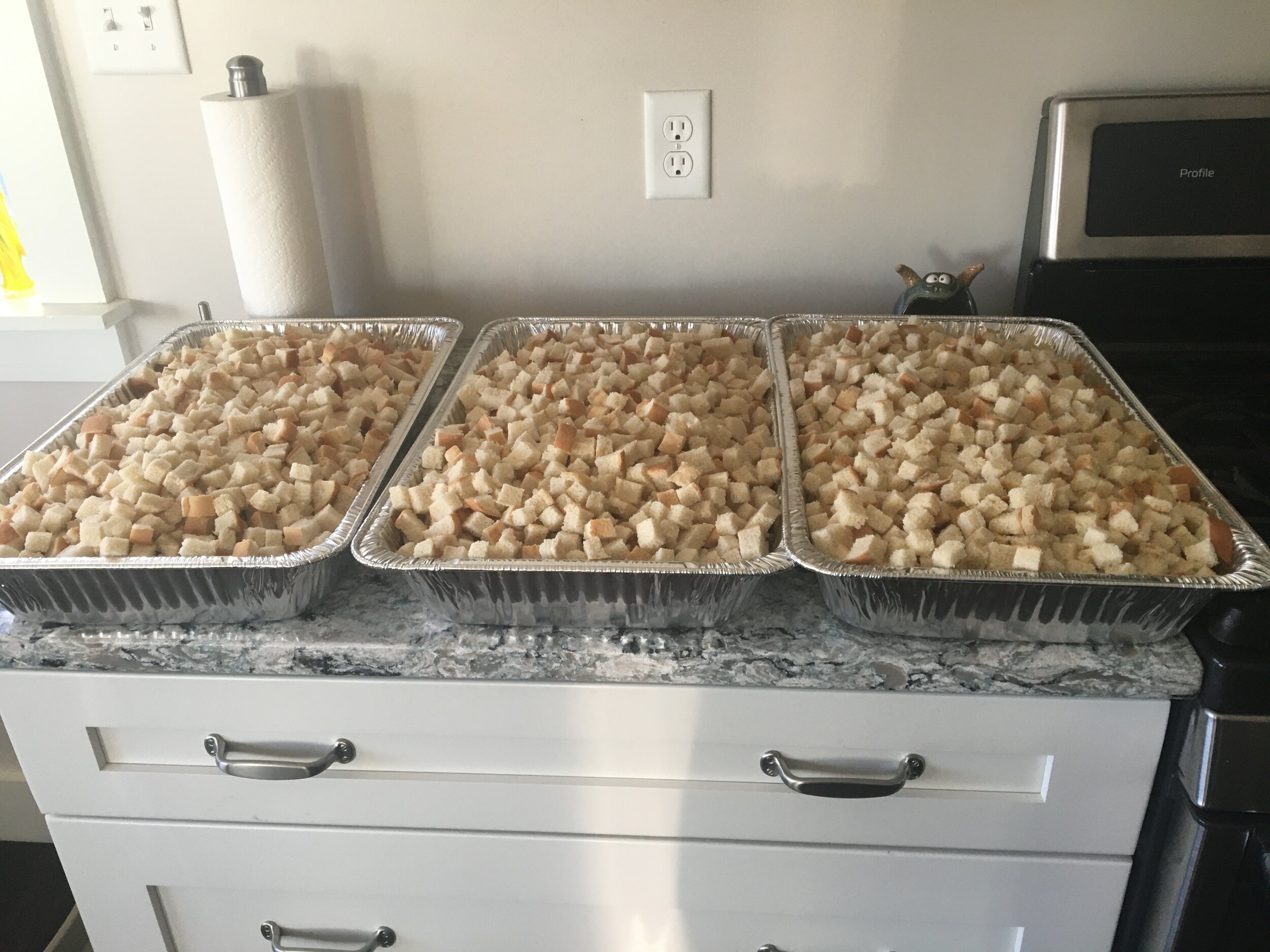All Hail The Stuffing Waffle
There are oodles of articles out there about how much food is wasted by the average family over the course of the year. It goes without saying that the more money you spend on food, the less money you have to put towards your FI journey. A key to saving both time and money is eating leftovers. And Thanksgiving offers the absolute queen of all leftover opportunities, the stuffing waffle. So plan ahead folks and make the same amount of stuffing for your reduced crowd Thanksgiving.
This is so freaking delicious.
The stuffing waffle is the perfect platform for all of your Thanksgiving related leftovers, you can try to fight us on this, but you’ll be wrong.
But in order to have stuffing waffles, you have to have stuffing. This is the recipe that has been somewhat adapted from my grandfather’s recipe. It’s somewhat adapted because he always made it, had a recipe, but nobody could make it the same way once he passed. This is as close as we’ve been able to come.
To make one of those big aluminum pan sized trays of stuffing you need:
3 Loaves bread, I use Maier’s Italian Bread, but you can use pretty much any bread
4 c each Onion + Celery
5 sticks + 2T butter
1.5 container Rubbed Sage
2 container leaf Marjoram
.5 container Thyme Leaves
2t salt
3 days before Thanksgiving, cube your bread and put it in the trays and leave it out uncovered to get nice and stale. Every day or so, kind of rotate the cubes so all of it gets as stale as possible, not just the top layer. The less moisture in the bread cubes, the more room there is to absorb the buttery goodness to come. Feel free to cut your onions and celery at the same time. They should be at around a 1/4 inch dice. You want them uniform and fairly small so they all cook down evenly.
Pre-COVID amounts of stuffing, when we had 25 people for dinner. Next year we’ll be back.
The day before Thanksgiving, or the morning of, you’re going to cook down the onions and celery and pour it over the stuffing. In a big frying pan melt 2 or 3 of the 5 (5!) sticks of butter down. Then add the onions and celery. You do not want to brown the onions or celery. You want to cook them down in a nice and easy buttery simmer. As the vegetables cook down and your house starts to smell divine, add in the remaining whole sticks of butter. You may or may not need the last 2T butter depending on how much liquid the onions and celery release. But don’t add any more than that. I know, after a pound and a quarter of butter, what’s 2T among friends. But the bottom line is you want the bread to be moist but not overly greasy. So use your best judgement and refine to your taste next year.
It’s going to take about 20 minutes for the onions and celery to break down. At that point, add the Sage, Marjoram, Thyme, and Salt. I say containers and use McCormick containers as my measurement. I have no idea how much is actually in each container by weight. The Sage is the bigger container, and the Thyme and Marjoram are those little 2 inch tall containers. Once you’ve added in the spices, continue to simmer until everything is blended and smells awesome.
When it’s done it should look like this.
Once it’s done, put it over the bread cubes in big spoonfuls. And then find the person in the house with the toughest hands, have them put on a pair of nitrile gloves or barbeque gloves and start working that boiling hot buttery goodness through the bread cubes. You can also try to use a spoon until it’s less hot but in the long run you’re going to need to use your hands to make sure it’s all mixed in. When you’re done the bread cubes should feel just barely damp and the celery mix should be evenly distributed throughout and nothing should feel soggy. Once you’re done, cover the tray in plastic wrap and either set it outside if you’re up north and not dropping to freezing over night or in the fridge in any other case. Though the tray takes up a lot of room so if you have a cold area in your garage or something that’s probably better.
On Thanksgiving, remove the plastic wrap, cover the tray with foil and bake for a half hour at 350 covered and then for another 10-15 minutes uncovered so the top gets brown and crispy. It’s not fussy, so if you’re heating other sides at 325 or 400, throw it in there at those temps just adjust the time. Sometimes the veggies migrate to the bottom of the pan overnight, so before you put it in the oven it’s a good idea to give the stuffing one more fluff with your hands to make sure it’s all mixed in and not clumped at the bottom of the pan.
Enjoy stuffing on Thanksgiving and plot to set some aside for the post Thanksgiving stuffing waffle.
Leftover turkey and gravy, the classic stuffing waffle topping.
To make a stuffing waffle, heat your waffle iron, take a big serving spoonful of leftover stuffing and plop it in the middle of the hot iron. Close the iron. Wait for a few minutes until you hear butter sizzling and it starts to smell like toasty stuffing. Flip the waffle onto a paper plate, because seriously, there were enough dishes on Thanksgiving. Top with reheated leftovers. We usually take a bunch of the leftover turkey and heat it up in leftover gravy and use that as a topping. But this would also be good with other reheated leftovers. I recommend heating the leftovers before putting them on the stuffing waffle so you don’t inadvertently cool it off.
The stuffing waffle contains the crispy topping of the original stuffing, the mushy seasoned part of the original stuffing, and is a little bit of goodness that you can look forward to all year long.
That’s the buzz around The Hive. There was another blog post in the queue but it was rightfully superseded by this one to give everyone time to make stuffing. What about you? What’s your favorite way to consume Thanksgiving leftovers?




